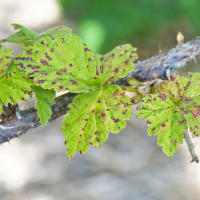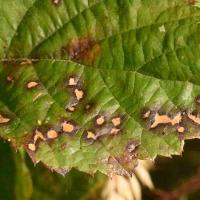Caneberry anthracnose
Elsinoe veneta
On first-year stems (primocanes). Minute, circular, purple spots (0.5-1.0 mm diam.) first appear on the surface of young red raspberry canes in late spring. As the cane grows, the spots increase in size, become elliptical with their major axis parallel to the main axis of the cane, and several spots may begin to coalesce. The centre of the spot becomes silvery white, though the margin remains purple and becomes slightly raised by mid-summer. After this stage the whitish centres slowly become sunken below the surface of the cane until they form elliptical pits with narrow purple margins in September. The deep pits frequently expose the phloem fibres under the deep-seated periderm (polyderm), and deep cracks parallel to the main axis of the cane may then expose other internal vascular tissues as canes become dormant in late autumn. Late summer infections lead to the development of small (1 mm diam.) superficial lesions from which sunken pits do not arise. In autumn, as the young cane turns brown, the spots become greyish-white and develop minute black dots (conidiomata), sometimes arranged in concentric circular patterns - a symptom described as the 'grey bark phase'. The lesions on primocanes of black raspberry are much larger and more conspicuous, with broad purple margins, than those of red raspberry.
The leaves on primocanes of red raspberries and young shoots of blackberries are also attacked. On primocane leaves of raspberry, lesions appear in late spring as minute, purple spots on the adaxial surface. These spots later develop a whitish centre, but do not increase in size any further, and a region of chlorosis around each lesion. In serious attacks, the leaf laminae may be covered in minute spot-lesions which often coalesce and the leaf may curl downwards or be shed prematurely. The petioles when attacked show elliptical lesions with whitish centres, similar to those forming on stems. In blackberry and blackberry x red raspberry hybrids, such as loganberry, tayberry and tummelberry, the lesions on leaf laminae are extremely conspicuous on the adaxial surface because they develop a broad reddish-purple margin and a greyish-white centre, and often coalesce to affect whole leaflets.
On fruiting stems (floricanes, or second-year canes). The epidermis of raspberry canes turn brown in autumn as the deep-seated stem periderm polyderm matures and the primary cortex and epidermis die. Consequently, over-wintered canes affected by cane spot do not show the purple margin around the pits, but the pits continue to deepen and the damage to vascular tissues becomes more evident in late winter and early spring as deep splits develop in areas and the phloem fibres (bast) are exposed. Secondary growth around the lesions leads to canker formation and distortion of the cane. Early infections in the previous year often lead to deep pits, girdling of the vascular cylinder and death of the stem above this point. Consequently, when the stems renew growth in spring, the lateral shoots may fail to develop, or wilt and desiccate soon after emergence. In heavily infected plantations in early spring, when conditions are moist and conducive for spore dissemination, it is possible for the laminae of emerging leaves on fruiting raspberry canes to be destroyed and no fruit produced. In blackberries, the primary cortex does not die at the end of the first summer because the periderm retains passage cells providing a connection to the internal vascular tissues. The purple margin around stem lesions may persist until the following spring. In raspberries, the grey bark phase or superficial infections become more conspicuous as the clustered black spots, sometimes in concentric patterns, differentiate into conidiomata.
On fruit. Infections occurring during flowering and early fruit development lead to dark reddish-purple, slightly sunken lesions on the green enlarging drupelets, partially obscured beneath the dense covering of white hairs (pubescence) on the drupelet surface. The affected drupelets fail to enlarge at the same rate as healthy ones; when the fruits ripen these smaller, pitted drupelets are slower to develop red pigments than the healthy drupelets and often appear orange-pink around the original dark reddish-purple lesion. The infected fruits are severely disfigured by the disease and unmarketable.









